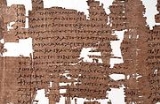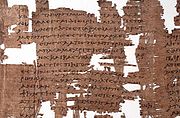
Artemidorus Ephesius
Encyclopedia

Strabo
Strabo, also written Strabon was a Greek historian, geographer and philosopher.-Life:Strabo was born to an affluent family from Amaseia in Pontus , a city which he said was situated the approximate equivalent of 75 km from the Black Sea...
, but only fragments of the work exist. (He is not the same as another Artemidorus of Ephesus who wrote an extant work in 5 books on dreams).
The Artemidorus papyrus
A papyrus containing a fragment already known as part of book 2 of his work has recently been discovered. It is known as the Artemidorus papyrus; it also contains the first map of the Iberian peninsulaIberian Peninsula
The Iberian Peninsula , sometimes called Iberia, is located in the extreme southwest of Europe and includes the modern-day sovereign states of Spain, Portugal and Andorra, as well as the British Overseas Territory of Gibraltar...
, and many illustrations.
This 10 feet (3 m) long papyrus roll was written in the first century, maybe in Alexandria
Alexandria
Alexandria is the second-largest city of Egypt, with a population of 4.1 million, extending about along the coast of the Mediterranean Sea in the north central part of the country; it is also the largest city lying directly on the Mediterranean coast. It is Egypt's largest seaport, serving...
. The copyist left spaces for illustrations of maps, and then sent it to a painter's workshop to have them inserted. But the painter designed only a partial map, which appears to be what the author believed was the shape of the southwestern Iberian peninsula.
The map is incomplete and has no names, and is perhaps the wrong map for the space in the papyrus. This ruined the roll. Instead the blank spaces were used as scrap papyrus for rough drafts, and to keep a catalog of drawings for clients. The drawings include pictures of real animals, such as giraffes, tigers and pelicans, as well as mythical ones, such as the griffin, marine snake or a dog with wings. In addition pictures of heads, feet and hands were drawn until there were no blank spaces.
The papyrus was then presumably sold as scrap paper. It was found in the early 1900s in the form of cartonnage
Cartonnage
Cartonnage is a type of material composing Egyptian funerary masks from the First Intermediate Period onward. It was made of layers of linen or papyrus covered with plaster. Some of the Fayum mummy portraits are also painted on panels made of cartonnage....
, as a filling for some kind of cavity (Konvolut). The cartonnage was sold to an Egyptian collector in whose hands it remained for 50 years. It then travelled around Europe, before being bought by a German collector who opened it and discovered the remains of the papyrus roll. It has holes in it, but because it got damp at some stage, even when there are holes, the drawings on those parts of the papyrus have been mirrored on the facing part of the roll.
The papyrus - which was bought by a foundation for $3,369,850 - is now owned by Turin's Banco di San Paolo.
A 2007 study by Canfora asserts that the text of the papyrus cannot be by Artemidorus as it contains words not available but in Byzantine Greek, and that the papyrus may be a forgery, perhaps by Constantine Simonides
Constantine Simonides
Constantine Simonides , palaeographer, dealer of icons, man with extensive learning, knowledge of manuscripts, miraculous calligraphy...
. Professor Richard Janko, in Classical Review 59.2(2009) pp. 403-410 has offered arguments favoring the case for forgery.
External links
- Feature Article on the critical edition of the papyrus (in German) http://www.archaeogate.org/storage/91_article_866_3.pdf (Part 1)] und http://www.archaeogate.org/storage/91_article_866_4.pdf (Part 2)]
- Article on papyrus
- Artemidorus papirus (in Spanish)
- The oldest occidental map shown in Turin (in Spanish)
- The oldest map of hispania (in Spanish)
- Images and Texts on the Artemidorus papirus

